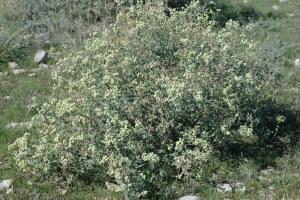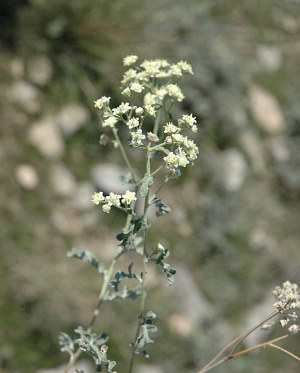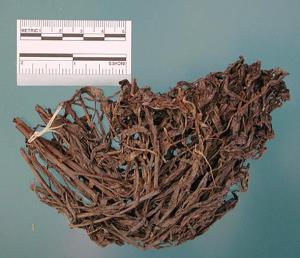Mariola
Parthenium incanum H.B.K.
Asteraceae (Sunflower/Composite Family)
Mariola is a small shrub with simple, alternate, deeply lobed and gray-green leaves that are covered with fine hairs. The small flowers bloom in clusters on short stalks. The plant has been used as a beverage and a medicine by several native groups.
The leaves and stems of mariola are very aromatic and bitter. Mariola grows from the Rio Grande Plains to the Edwards Plateau and westward to Arizona. It is closely related to the less broadly distributed guayule or rubber plant, and hybridizes with it throughout the range of the latter plant. Mariola produces about 2-3 percent rubber, while guayule produces 8-20 percent rubber, and hybridization of the two is said to reduce the rubber production of guayule (Powell 1998:420).
Mariola was collected from Amistad NRA on Evans Creek, in the upper reaches of the conservation pool during a low water period (AMIS 41393). Due to the recent rise in the water level of the reservoir, the area is probably inundated. Mariola is widespread in the region, often growing along ridges and just below canyon rims and has been observed near Shumla Bend and around Langtry, Texas.
Archeological occurrence. As a medicinal or beverage plant, mariola would be recovered during archeological excavations only in specially curated contexts, such as caches or burials. A carefully folded dried mariola plant was recovered from Fate Bell Shelter. Neither the precise context, nor significance is known, but the find suggests that native peoples of the area found uses for mariola.
Beverages and medicine. Mariola was brewed into a beverage by the Apache, who boiled the fresh leaves and used it like coffee, giving it the name gaxe (Castetter and Opler 1936:53). Parthenium hysterophorous, a widespread herb and very close relative of mariola, is used in Mexico in a decoction to treat rheumatism and other aches and pains, and to treat liver ailments (Martinez 1969:68-69). Readers should are warned that many people are allergic to the latex and sap of members of the genus Parthenium. Mariola was historically used by native peoples that lived with the plant for hundreds of years and who probably developed some immunity to the irritant properties of the sap.
References:
Castetter Edward F., and Morris Opler
1936 The Ethnobiology of the Chiricahua and Mescalero Apache. A. The Use of Plants for Foods, Beverages, and Narcotics. Ethnobiological Studies in the American Southwest. Vol. III. The University of New Mexico Bulletin, Biological Series 4(5), Albuquerque, New Mexico.
Martinez, Maximino
1969 Las Plantas Medicinales de Mexico. Quinta Edicion. Ediciones Botas, Mexico City.
Powell, A. Michael
1998 Trees and Shrubs of the Trans-Pecos and Adjacent Areas. University of Texas Press, Austin, Texas.
![]()


